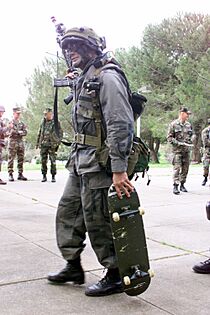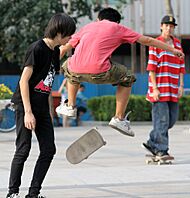Skateboarding facts for kids

Skater in front of the Barclays Center in Brooklyn, New York (2019)
|
|
| Highest governing body | World Skate |
|---|---|
| Characteristics | |
| Mixed-sex | Yes, separate competitions |
| Presence | |
| Country or region | Worldwide |
| Olympic | Since 2020 |
Skateboarding is an action sport that involves riding and performing tricks using a skateboard, as well as a recreational activity, an art form, an entertainment industry job, and a method of transportation. Originating in the United States, skateboarding has been shaped and influenced by many skateboarders throughout the years. A 2009 report found that the skateboarding market is worth an estimated $4.8 billion in annual revenue, with 11.08 million active skateboarders in the world. In 2016, it was announced that skateboarding would be represented at the 2020 Summer Olympics in Tokyo, for both male and female teams.
Since the 1970s, skateparks have been constructed specifically for use by skateboarders, freestyle BMXers, aggressive skaters, and more recently, scooters.
Contents
Trick skating
With the evolution of skateparks and ramp skating, the skateboard began to change. Early skate tricks had consisted mainly of two-dimensional freestyle maneuveres like riding on only two wheels ("wheelie" or "manual"), spinning only on the back wheels (a "pivot"), high jumping over a bar and landing on the board again, also known as a "hippie jump", long jumping from one board to another, (often over small barrels or fearless teenagers), or slalom. Another popular trick was the Bertlemann slide, named after Larry Bertelemann's surfing maneuveres.
In 1976, skateboarding was transformed by the invention of the ollie by Alan "Ollie" Gelfand. It remained largely a unique Florida trick until the summer of 1978, when Gelfand made his first visit to California. Gelfand and his revolutionary maneuvers caught the attention of the West Coast skaters and the media where it began to spread worldwide. The ollie was adapted to flat ground by Rodney Mullen in 1982. Mullen also invented the "Magic Flip", which was later renamed the kickflip, as well as many other tricks including the 360 Kickflip, which is a 360 pop shove-it and a kickflip in the same motion. The flat ground ollie forms the basis of many street skating tricks, allowing skateboarders to perform tricks in mid-air without any more equipment than the skateboard itself. A recent development in the world of trick skating is the 1080, which was first ever landed by Tom Schaar in 2012.
Skate shoe
Whilst early skateboarders generally rode barefoot, preferring direct foot-to-board contact, and some skaters continue to do so, one of the early leading trends associated with the sub-culture of skateboarding itself, was the sticky-soled slip-on skate shoe, most popularized by Sean Penn's skateboarding character from the film Fast Times at Ridgemont High. Because early skateboarders were actually surfers trying to emulate the sport of surfing, at the time when skateboards first came out on the market, many skateboarded barefoot. But skaters often lacked traction, which led to foot injuries. This necessitated the need for a shoe that was specifically designed and marketed for skateboarding, such as the Randy "720", manufactured by the Randolph Rubber Company, and Vans sneakers, which eventually became cultural iconic signifiers for skateboarders during the 1970s and '80s as skateboarding became more widespread.
While the skate shoes design afforded better connection and traction with the deck, skaterboarders themselves could often be identified when wearing the shoes, with Tony Hawk once saying, "If you were wearing Vans shoes in 86, you were a skateboarder". Because of its connection with skateboarding, Vans financed the legendary skateboarding documentary Dogtown and Z-Boys and was the first sneaker company to endorse a professional skateboarder Stacy Peralta. Vans has a long history of being a major sponsor of many of skateboarding's competitions and events throughout skateboarding's history as well, including the Vans Warped Tour and the Vans Triple Crown Series.
As it eventually became more apparent that skateboarding had a particular identity with a style of shoe, other brands of shoe companies began to specifically design skate shoes for functionality and style to further enhance the experience and culture of skateboarding including such brands as; Converse, Nike, DC Shoes, Globe, Adidas, Zoo York and World Industries. Many professional skateboarders are designed a pro-model skate shoe, with their name on it, once they have received a skateboarding sponsorship after becoming notable skateboarders. Some shoe companies involved with skateboarding, like Sole Technology, an American footwear company that makes the Etnies skate shoe brand, further distinguish themselves in the market by collaborating with local cities to open public skateparks, such as the etnies Skatepark in Lake Forest, California.
Skateboard deck
Individuality and a self-expressed casual style have always been cultural values for skateboarders, as uniforms and jerseys are not typically worn. This type of personal style for skateboarders is often reflected in the graphical designs illustrated on the bottom of the deck of skateboards, since its initial conception in the mid-seventies, when Wes Humpston and Jim Muri first began doing design work for Dogtown Skateboards out of their garage by hand, creating the very first iconic skateboard-deck art with the design of the "Dogtown Cross".
Prior to the mid-seventies many early skateboards were originally based upon the concept of “Sidewalk Surfing” and were tied to the surf culture, skateboards were surfboard like in appearance with little to no graphics located under the bottom of the skateboard-deck. Some of the early manufactured skateboards such as "Roller Derby", the "Duraflex Surfer" and the "Banana board" are characteristic. Some skateboards during that time were manufactured with company logo's or stickers across the top of the deck of the skateboard, as griptape was not initially used for construction. But as skateboarding progressed and evolved, and as artists began to design and add influence to the artwork of skateboards, designs and themes began to change.
There were several artistic skateboarding pioneers that had an influence on the culture of skateboarding during the 1980s, that transformed skateboard-deck art like Jim Phillips, whose edgy comic-book style "Screaming Hand", not only became the main logo for Santa Cruz Skateboards, but eventually transcended into tattoos of the same image for thousands of people and vinyl collectible figurines over the years. Artist Vernon Courtlandt Johnson is said to have used his artwork of skeletons and skulls, for Powell Peralta, during the same time that the music genres of punk rock and new wave music were beginning to mesh with the culture of skateboarding. Some other notable skateboard artists that made contributions to the culture of skateboarding also include Andy Jenkins, Todd Bratrud, Neil Blender, Marc McKee, Tod Swank, Mark Gonzales, Lance Mountain, Natas Kaupas and Jim Evans.
Over the years skateboard-deck art has continued to influence and expand the culture of skateboarding, as many people began collecting skateboards based on their artistic value and nostalgia. Productions of limited editions with particular designs and types of collectible prints that can be hung on the wall, have been created by such famous artists as Andy Warhol and Keith Haring. Most professional skateboarders today have their own signature skateboard decks, with their favorite artistic designs printed on them using computer graphics.
High value and collectible skateboards
In January 2019, Sotheby's in New York auctioned the full set of the 248 skateboard deck designs ever sold by Supreme, collected by Ryan Fuller. The full set sold for $800,000 to 17 year old Carson Guo from Vancouver who plans to exhibit them in a local gallery.
New York based SHUT Skateboards had a goldplated skateboard for sale at $15,000 in 2014, then the most expensive skateboard in the world.
In 2019, artist Adrian Wilson created the SUPREME Mundi, a cross between an artist palette and a skateboard as a commentary on the record bids at auction of the Supreme decks and the restored Salvatore Mundi which was sold by a New York art gallery for $20,000
Safety
Skateboards, along with other small-wheeled transportation such as in-line skates and scooters, suffer a safety problem: riders may easily be thrown from small cracks and outcroppings in pavement, especially where the cracks run across the direction of travel. Hitting such an irregularity is the major cause of falls and injuries. The risk may be reduced at higher travel speeds.
Severe injuries are relatively rare. Commonly, a skateboarder who falls suffers from scrapes, cuts, bruises, and sprains. Among injuries reported to a hospital, about half involve broken bones, usually the long bones in the leg or arm. One third of skateboarders with reported injuries are very new to the sport, having started skating within one week of the injury. Although less common, involving 3.5–9 percent of reported injuries, traumatic head injuries and death are possible severe outcomes.
Skating as a form of transportation exposes the skateboarder to the dangers of other traffic. Skateboarders on the street may be hit by other vehicles or may fall into vehicular traffic.
Skateboarders also occasionally pose a risk to other pedestrians and traffic. If the skateboarder falls, the skateboard may roll or fly into another person. A skateboarder who collides with a person who is walking or biking may injure or, rarely, kill that person.
Many jurisdictions require skateboarders to wear bicycle helmets to reduce the risk of head injuries and death. Other protective gear, such as wrist guards, also reduce injury. Some medical researchers have proposed restricting skateboarding to designated, specially designed areas, to reduce the number and severity of injuries, and to eliminate injuries caused by motor vehicles or to other pedestrians.
The use, ownership and sale of skateboards were forbidden in Norway from 1978 to 1989 because of the high number of injuries caused by boards. The ban led skateboarders to construct ramps in the forest and other secluded areas to avoid the police. There was, however, one legal skatepark in the country in Frogner Park in Oslo.
Other uses and styles
Transportation
The use of skateboards solely as a form of transportation is often associated with the longboard. Depending on local laws, using skateboards as a form of transportation outside residential areas may or may not be legal. Backers cite portability, exercise, and environmental friendliness as some of the benefits of skateboarding as an alternative to automobiles.
Military

The United States Marine Corps tested the usefulness of commercial off-the-shelf skateboards during urban combat military exercises in the late 1990s in a program called Urban Warrior '99. Their special purpose was "for maneuvering inside buildings in order to detect tripwires and sniper fire".
Trampboarding
Trampboarding is a variant of skateboarding that uses a board without the trucks and the wheels on a trampoline. Using the bounce of the trampoline gives height to perform tricks, whereas in skateboarding one needs to make the height by performing an ollie. Trampboarding is seen on YouTube in numerous videos.
Swing boarding
Swing boarding is the activity where a skateboard deck is suspended from a pivot point above the rider which allows the rider to swing about that pivot point. The board swings in an arc which is a similar movement to riding a half pipe. The incorporation of a harness and frame allows the rider to perform turns and spins all while flying through the air.
Images for kids
-
Skateboarder in Manhattan, New York (2008)
-
Skateboarder in Grants Pass, Oregon (2010)
-
Skateboarder at Skateistan in Kabul, Afghanistan (2011)
-
Nicholas Deconie frontside five-0 at Millennium Skate Park in Brooklyn, New York (2019)
-
Skaters await their turn during the best trick contest at the Coleman Playground Skatepark in Manhattan, New York. (2019)
-
Brazil's Luiz Francisco competing in the 2020 Summer Olympics final at the Ariake Urban Sports Park in Tokyo on August 5, 2021
See also
 In Spanish: Monopatinaje para niños
In Spanish: Monopatinaje para niños
- Skateboarding trick
- Carveboarding (or Surfskating)










